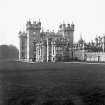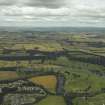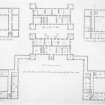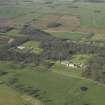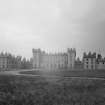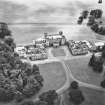Pricing Change
New pricing for orders of material from this site will come into place shortly. Charges for supply of digital images, digitisation on demand, prints and licensing will be altered.
Floors Castle
Country House (Period Unassigned)
Site Name Floors Castle
Classification Country House (Period Unassigned)
Alternative Name(s) Floors Castle Policies
Canmore ID 58454
Site Number NT73SW 5
NGR NT 71110 34670
Datum OSGB36 - NGR
Permalink http://canmore.org.uk/site/58454
First 100 images shown. See the Collections panel (below) for a link to all digital images.
- Council Scottish Borders, The
- Parish Kelso
- Former Region Borders
- Former District Roxburgh
- Former County Roxburghshire
Floors Castle and its surrounding lands lie to the west of Kelso, overlooking the Tweed. Until the Reformation, the Abbey of Kelso held the estate; thereafter King James VI granted them to one of his favourites, Robert Ker of Cessford, who later became Earl of Roxburghe. The Kers remained a powerful force in politics and the 5th Earl was instrumental in assuring the Union of Parliaments in 1707. As a reward he became the 1st Duke of Roxburghe that year. To reflect his new status, work began on a new residence at Floors in 1721, transforming an old tower-house into a Georgian mansion.
William Adam was the architect responsible for designing and building the new mansion, though the Duke appears to have influenced the end result. According to contemporary accounts, the mansion was a fairly plain oblong building with towers projecting at each corner. On either side was a pavilion which housed stables and kitchens.
Around 1837, the Castle was significantly remodelled at the request of the 6th Duke, who asked William Henry Playfair to redesign Floors. It is to Playfair that Floors owes its immediately distinctive character and it seems that his aim was to create a mansion fit for the beautiful setting of the Tweed valley. It consists of a four-storeyed and basement, flat-roofed main range, with square towers at each corner, and a two-storeyed extension on the east side. There are flanking single-storeyed ranges on the garden front, behind which are two- and three-storeyed blocks of service accommodation, ranged around open courtyards.
Inspiration for the building can be seen in Playfair's work at George Heriot's and Donaldson's Hospitals in Edinburgh. The mansion incorporates features designed to give it the feel of a castle, with battlemented parapets, pepper-pot angle-turrets as well as ornate water-spouts at the head of every wall and cupolas crowning each turret and tower. Playfair added a 'port-cochere', or a porch designed to allow a carriage under it, to the main door entrance. Amongst other features incorporated into Floors by Playfair were facilities for smoking salmon and kippers, essential for any large Victorian country house.
Playfair also redesigned much of the interior and his drawings and plans survive. Successive Duchesses have also left their own impression on the interior, creating the effect seen today.
Text prepared by RCAHMS as part of the Accessing Scotland's Past project
NT73SW 5.00 71110 34670
(NT 7110 3467) Floors Castle (NAT)
OS 6" map, (1938).
NT73SW 5.01 NT 7110 3467 Garden
NT73SW 5.02 NT 708 342 Formal Garden
NT73SW 5.03 NT 70593 34907 Kennels and Gamekeeper's House
NT73SW 5.04 NT 70753 34985 Home Farm (including sawmill)
NT73SW 5.05 NT 72199 34419 and NT 72216 34444 Gateway and Lodges (Entrance Gates)
NT73SW 5.06 Centred NT 7066 3451 Formal Garden
NT73SW 5.07 NT 70593 34907 Icehouse
NT73SW 5.08 NT 71355 34380 Holly Tree
For (associated) pond, see NT63SE 38.
See also:
NT73SW 9 NT 7034 3353 Cist
NT73SW 51 NT 719 343 Burgh (West Kelso)
NT73SW 57 NT 7220 3439 Lodge Park excavations (occupation site)
NT73SW 81 Centred NT 7030 3370 Wester Anna (cropmarks)
Floors Castle. Sir John Vanburgh is believed to have designed this seat for the first Duke of Roxburghe, in 1718. Originally it consisted of an oblong main block with towers at the four corners standing at the back of a forecourt open to the NW and enclosed on the NE by the East Pavillion, or stables, and on the SW by the West Pavillion, or offices. The whole had a frontage of 412ft. From 1838 to 1849 Vanburgh's design was modified and enhanced by W H Playfair of Edinburgh.
RCAHMS 1956.
The residence of the Duke of Roxburgh.
Visited by OS (RDL) 6 December 1963.
NT73SW 5.00 71110 34670 Floors Castle
NT73SW 5.01 7110 3467 Garden
NT73SW 5.02 708 342 Formal Garden
NT73SW 5.03 70593 34907 Kennels
NT73SW 5.04 70753 34985 Home Farm
NT73SW 5.05 72199 34419 Lodges
NT73SW 5.06 707 345 Formal Garden
NT73SW 5.07 70593 34907 Icehouse
NT73SW 5.08 71355 34380 Holly Tree
For pond, see NT63SE 38.
(NT 7110 3467) Floors Castle (NAT)
OS 6" map, (1938).
OWNER: Duke of Roxburghe
ARCHITECT: William Adam, 1718
Robert Adam, 1772 - 1777 - different designs for a new house. Possibly additions to the 1718 house
William Playfair, 1839 - alterations and additions
Reginald Fairlie, 1929 - entrance gates and lodges
Information from Architecture Catalogue slips:
DRAWING ROOM CHIMNEY-PIECE
Drawing in Edinburgh University Library Playfair Collection
'No 627 13th Feb 1845.' Shows chimney-piece as in Christies photographs but omits caryatids and central tablet. Also detail drawings for profiles and mouldings at full size.
Letter in Playfair Letter Book Edinburgh University Library 26th Feb 1845
W H Playfair to the Duke of Roxburghe
'Sent sketches for proposed chimney piece for large drawing room' (to be of white marble and curvilinear like those in other rooms)
'To make a variety however and to stamp upon this chimneypiece a superior excellence I have introduced two female figures as Caryatids supporting the shelf - as these, however, to be worthy of the room must be respectable works of art, I have sought and obtained a cast of a figure done in Thorvaldsen's studio by some pupil and probably under his eye. I have it from young Ritchie a sculptor who studied under Thorvaldsen and is very clever.'
If Duke approves, Ritchie to be asked to make a model and then cut the figures. Probably cost (pounds)300.
'The shelf will project considerably from the wall and is kept low so as to form a capital place for a French Clock and any other ornamental objects'
The marble work of the chimney-piece was made by David Ness of Edinburgh. Ritchie only cut the figures and tablet.
PLASTER CEILING
Albert ... made a Baroque plaster ceiling for Floors - rejected by the Duke or Factor, it was installed in the Bank of Scotland on the Mound.
REFERENCE:
EDINBURGH UNIVERSITY LIBRARY
Playfair Collection 1837 630 sheets (P. 27, 28, 29)
Floors West Lodge 31 sheets
PUBLIC LIBRARY
- Border Magazine, June 1897 - 3 photographs
- Scots Magazine, January 1810 - 1 engraving
SCOTTISH RECORD OFFICE
Kelso, Floors Castle
A note of what was 'sighted in the house of the Floores' by Sir Andrew Ker of Greinheid, Andrew Ker of Chatto, Andrew Ker of Maisondew and Alexander Don, Clerk of Kelso, for William, Earl of Roxburgh.
Report on the condition of the house and its furnishing.
1650 GD 220/6/501/34
Letter from Henry McGie in Dumfries to [ - ].
He has heard that the Duke of Roxburgh has built a magnificent palace. He understand that the recipient of his letter has the ordering of its finishing and painting so he asks if he might be employed.
1724 GD 205/Box37/portfolio77
William Adam, architect, writes to Sir John Clerk that he has been ordered by the Duke of Roxburgh 'to attend at Floors'.
1726 GD 18/4729/2
NMRS REFERENCES:
Soane Museum Drawings - Adam Collection
Vol. 37 Nos. 12 - 16 7 prints: plans and elevations of 1st design
Nos. 17 - 23 12 prints: plans and elevations of 2nd design
Nos. 24 - 28 5 prints: plans and elevations of 3rd design
Nos. 29 - 30 2 prints: plans and elevations of 2 designs for lodge and gates
Vol. 46 Nos.174 - 176 3 prints: plans and elevation of Porter's Lodge
Vol. 51 No. 93 1 print of gateway in castle syle
Vitruvius Scoticus, Pl.48 and 49 2 prints: plans and elevation
Copies of drawings at Floors Castle:
W.H. Playfair, 1837 - 43 26 photographs: plans, sections, elevations of kitchen court etc. and house as existing
NMRS LIBRARY
- Country Life, May 11th and 18th, 1978 - text, photographs
- John Geddie, 'Historic Houses of the UK', 1891, page 31 - text, illustration and plan
The following references are listed in the NMRS database Bibliography:
NMRS LIBRARY
- Guide book to Floors Castle (Anon., c.1960) for use by visitors: text, photographs.
(A later enlarged edition, post-1965, is also held)
- Articles by Shiela Forman
Note: There is another article by Shiela Forman in Scottish Field, October 1947 not held in NMRS
NMRS PRINTROOM
- Catalogue No.25. Sale Catalogue. FLOORS CASTLE. Sale held on 17th September 1990 by Christies Scotland. Auction held on the premises by instruction of the Duke of Roxburgh. Sale was of 'items surplus to requirements and included Furniture, Chimneypieces, Pictures, Porcelain, Silver and Textiles.' Also objects of art and prints.
Catalogue illustrated with colour and blakc and white photographs.
(266 x 211)
- 'The Scottish Border: A Memorial of Her Majesty's Visit to the District, August 1867'
Contains description of castle in 1867
Photographic Survey (1956)
Photographic survey by the Scottish National Buildings Record in 1956.
Photographic Survey (1956)
Photographic survey by the Scottish National Buildings Record in 1956.
Publication Account (1985)
The present imposing and well-grouped buildings appear at the same time both solidly four-square and flamboyantly embattled! W H Playfair (1789-1857) began his remodelling in 1838 for the sixth Duke of Roxburghe; he was also engaged in restoring Heriot's Hospital at the time, and building the new Donaldson's Hospital-both of them in Edinburgh and both of them an influence on Floors. He started with the east Pavilion or stables, continued with the west Pavilion in 1841, and completed the main block about 1849. Hood-moulds were added above all the windows; corbelling, castellated parapets and ornate water-spouts to the wall-heads; and pepper-pot turrets to the corners of the towers. He built further turrets in the re-entrant angles (the inward-looking angles made by two adjoining walls); and, at the north-west front entrance, the porch admitted a carriage below it-a porte-cochere. Bay windows within the angles either side helped break up the solid mass of masonry.
This wealth of architectural detail quite transformed the plain Georgian mansion designed for the first duke in 1718-a design that may have been added to by the time of its completion in 1721 by William Adam. This earlier house consisted of a rectangular main block with a tower at each corner, two pavilions and a forecourt.
Playfair's house is much more in tune with the site, however-a superb location on a terrace overlooking the Tweed and the remains ofRoxburgh Castle. Far beyond lie the Cheviots.
Information from 'Exploring Scotland's Heritage: Lothian and Borders', (1985).
Sbc Note
Visibility: This is an upstanding building.
Information from Scottish Borders Council.
























































































































